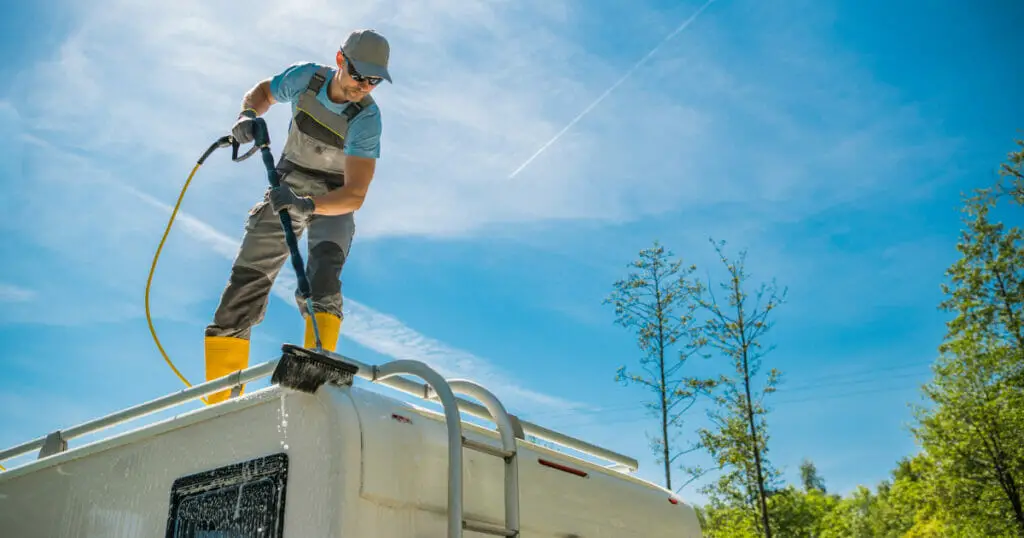RV roof sealant is an amazing product that can protect your beloved RV from damage and leaks. RV roof sealant is a powerful material that creates a barrier on the roof of your RV to prevent water damage and leaks. It is the ultimate solution to keep the interior of your RV safe and dry, even in the harshest weather conditions. It is an essential part of RV maintenance that can keep your vehicle in top condition for years to come.
Maintaining the roof of your RV is crucial to ensuring its longevity and maximum resale value. By taking care of your RV roof, you can prevent costly repairs and maintain the value of your investment. Regular maintenance, including the application of roof sealant, is an easy and effective way to achieve this. In this article, we will discuss the different types of RV roof sealant, how to apply it like a pro, how to maintain it, and how long it can typically last.
I. Why is RV Roof Sealant Important?
RV roof sealant is an important part of RV maintenance. It is vital for protecting your RV’s roof from weather damage, leaks, and other potential problems that might jeopardize the integrity of your RV. RV roof sealant forms a protective barrier between your RV roof and the environment, which may cause considerable damage over time, such as rain, snow, and UV rays. Sealant can help keep your RV dry and free of costly water damage by keeping water and other debris from entering through the roof.
Furthermore, RV roof sealant can extend the life of your RV by reducing the need for costly repairs. By applying the sealant to your RV roof on a regular basis, you can help maintain its structural integrity and avoid leaks that might cause serious damage down the road. Repairing a damaged RV roof may be costly, so investing in sealant is a cost-effective method to safeguard your investment and guarantee that you can enjoy your RV for many years to come.
RV roof sealant is critical for protecting your RV from the weather, avoiding water damage, and extending the life of your vehicle. By applying the sealant to your RV roof on a regular basis, you may help it retain structural integrity and avoid costly repairs.
II. Types of RV Roof Sealants
There are several types of RV roof sealants on the market now. Below are the most prevalent varieties, along with their advantages and disadvantages:
1. Silicone Sealant:
Because of its long-lasting and flexible qualities, silicone sealant is a popular option among RV owners. It resists UV radiation, temperature fluctuations, and moisture, making it an excellent choice for RV roofs. Silicone sealant, on the other hand, can be difficult to work with and may not cling well to some types of roofing materials.
2. Acrylic Sealant:
Another popular alternative for RV owners is the acrylic sealant. It is simple to apply and may be used on a wide range of roofing materials. The acrylic sealant also dries rapidly, which is useful if you need to apply it quickly. Acrylic sealers, on the other hand, may not be as long-lasting as silicone or polyurethane sealants.
3. Polyurethane Sealant:
A highly durable alternative that is resistant to weather and temperature fluctuations is polyurethane sealant. It is noted for its outstanding adherence and can be applied to a number of various roofing materials. Nevertheless, polyurethane sealant is more costly than silicone sealant and may not be as flexible.
While deciding on the finest RV roof sealant for your needs, take into account the type of roofing material on your RV, as well as your budget and personal tastes. Silicone sealant is a wonderful choice for most RV roofs since it is flexible, long-lasting, and weather- and temperature-resistant. Acrylic sealant, on the other hand, maybe a more cost-effective solution while still providing enough protection, while polyurethane sealant is great for people who value durability and long-term protection. Finally, the decision will be based on your unique demands and preferences.
III. How to Choose the Right RV Roof Sealant
Choosing the right RV roof sealant is essential to ensuring the longevity and protection of your RV’s roof. Here’s a step-by-step guide to help you choose the right sealant:
Step 1: Determine the Type of RV Roof
The first step is to determine the type of roof your RV has. RV roofs are typically made of rubber, fiberglass, aluminum, or TPO. Different sealants are suitable for different types of roofs, so it’s important to identify your RV’s roof type.
Step 2: Consider the Climate
The climate of your region is also an essential factor to consider when selecting a sealant. If you live in an area with extreme temperatures or harsh weather conditions, you will need a sealant that can withstand these conditions.
Step 3: Choose a High-Quality Sealant
It’s essential to choose a high-quality sealant to ensure the best results. High-quality sealants are designed to last longer, provide better protection against leaks, and resist damage from UV rays.
Step 4: Consider Your Budget
Sealants are available at different price points, so it’s important to consider your budget. However, it’s important not to compromise on quality to save money, as a low-quality sealant may not provide adequate protection.
Step 5: Consult with Experts
If you’re not sure which sealant is best for your RV, it’s always a good idea to consult with experts. RV dealers, mechanics, and experienced RV owners can provide valuable advice and recommendations based on their experience.
Selecting the right RV roof sealant requires consideration of several factors, such as the type of RV roof, climate, and budget. Choosing a high-quality sealant is essential for the best results and consulting with experts can provide additional guidance.
IV. Steps to Apply RV Roof Sealant
RV roof sealant application is a necessary maintenance operation that may help protect your RV from leaks and damage. Here’s a step-by-step tutorial for applying RV roof sealant:
Step 1: Wash the Roof
Begin by thoroughly washing the roof with an RV roof cleaning solution. Rinse the roof with water after scrubbing it with a soft-bristle brush. Be certain that all dirt, debris, and prior sealant residue are removed from the roof surface. Let the roof completely dry before moving on to the next step.
Step 2: Preparation of the Surface
Examine the roof for cracks, gaps, or damaged areas. If you find any, fix them using patching material or RV roof tape. Before using the patching material, make sure to properly follow the manufacturer’s directions.
Step 3: Put on the Sealant
Pick the best sealant for your RV’s roof and environment. Before applying the sealant, carefully follow the manufacturer’s recommendations. Begin by putting the sealant on the roof and evenly distributing it using a roller or brush. Apply the sealant in a thick, even coat across the whole roof surface. Fill up any gaps or cracks using a putty knife.
Step 4: Let the sealant dry
Let the sealant cure completely after application. Depending on the type of sealant and the weather, this might take many hours or even days. For the suggested drying time, consult the manufacturer’s instructions.
Step 5: Examine the Sealant
When the sealant has dried, thoroughly check it for any gaps or spots that may require touch-ups. Apply an additional coat of sealant if necessary to achieve a complete covering.
Key Security Measures:
To avoid skin and eye irritation, use gloves, goggles, and protective clothes when applying sealant.
To prevent inhaling sealant fumes, work in a well-ventilated location.
Apply sealant to a wet or damp roof surface only.
Keep dogs and youngsters away from the work area.
Washing the roof, prepping the surface, applying the sealant in a thick and even coating, allowing it to cure fully, and examining it for any touch-ups are all steps in applying RV roof sealant. While applying the sealant to your RV roof, it’s critical to carefully follow the manufacturer’s directions and take safety precautions.
V. Maintaining Your RV Roof Sealant
Maintaining your RV roof sealant is critical for long-term protection and avoiding leaks and damage. Here are some recommendations for keeping your RV roof sealant in good condition:
1. Check the Roof on a Regular Basis.
Regularly inspect the RV roof sealant for cracks, gaps, and other signs of wear and tear. Examine any locations where the sealant has lifted or peeled. After any big weather occurrences, such as strong rain or hail, inspect the roof to check that the sealant is still intact.
2. Ensure that the roof is clean.
Clean the RV roof on a regular basis to remove any dirt, debris, or other impurities that might harm the sealant. Clean the roof with a light detergent and a soft-bristle brush, then thoroughly rinse it with water. Avoid using abrasive scrubbers or aggressive chemicals that might harm the sealant.
3. Reapply Sealant as Needed.
Reapply the sealant as soon as possible if you find any cracks or holes in the sealant, or if the sealant has worn off in some locations. Before applying fresh sealant, carefully follow the manufacturer’s directions and let it cure completely before exposing it to the outdoors.
4. Keep the roof safe against harsh weather conditions.
Keep the RV roof safe from strong weather conditions that might harm the sealant. During periods of extreme heat or cold, cover the RV with a protective tarp, and avoid parking under trees or other things that may fall onto the roof. Consider adding an RV roof cover for further protection.
In short, keeping your RV roof sealant entails examining and cleaning the roof on a regular basis, reapplying sealant as needed, and protecting the roof from harsh weather conditions. You can guarantee that your RV roof sealant offers long-lasting protection for your RV by following these maintenance guidelines.
Conclusion
RV roof sealant is critical for preventing leaks and damage from weather and other causes. Selecting the correct sealant necessitates taking into account elements such as the type of RV roof, climate, and budget. Cleaning the roof, prepping the surface, applying the sealant, allowing it to cure, and examining it for any touch-ups are all steps in applying RV roof sealant. Maintaining the RV roof sealant entails inspecting and cleaning the roof on a regular basis, reapplying sealant as needed, and protecting the roof from extreme weather conditions.
To keep your RV roof in good condition, use a high-quality sealant and carefully follow the manufacturer’s directions while applying and maintaining it. Inspections and cleaning on a regular basis can help avoid damage and leaks, and reapplying sealant as needed can assure long-term protection. Finally, shielding your RV roof from inclement weather can help extend the life of the sealant and avoid damage to your vehicle. By Following these guidelines, RV owners may keep their RV roofs in good condition and travel with peace of mind.



